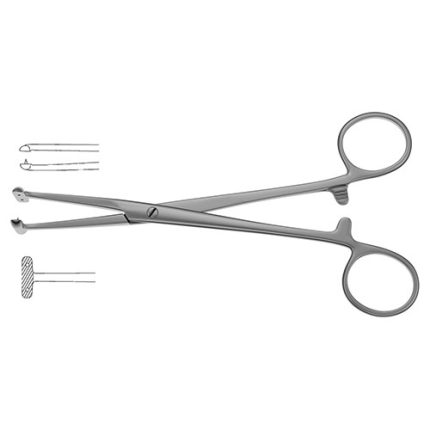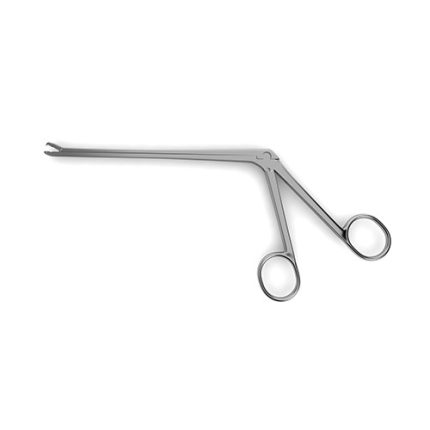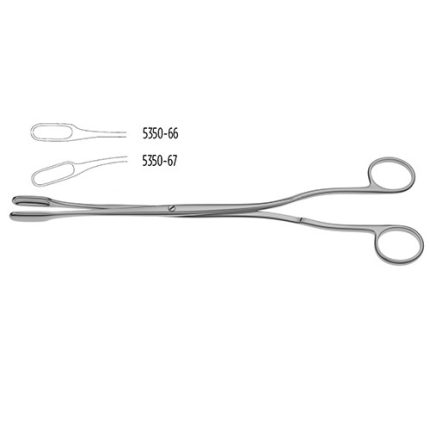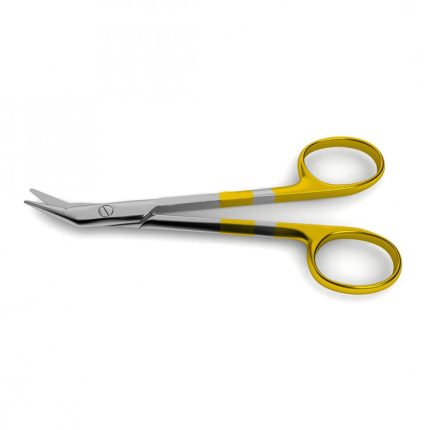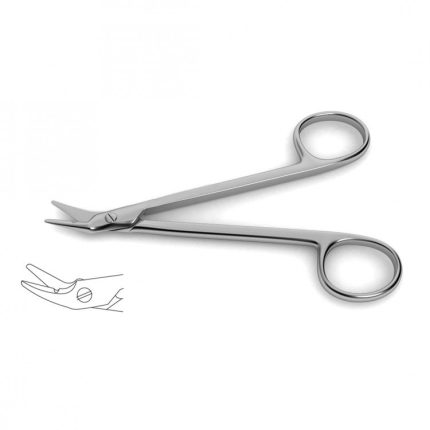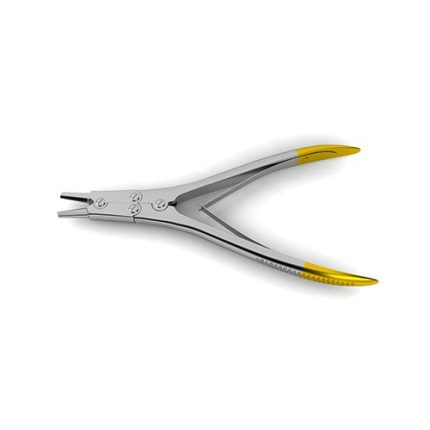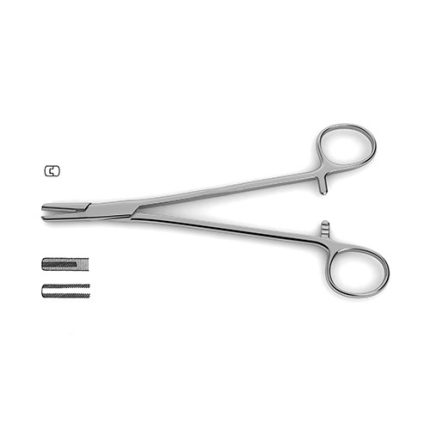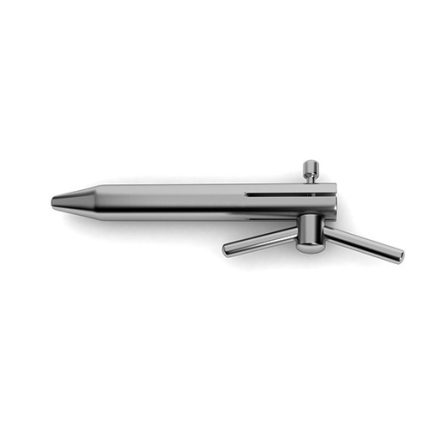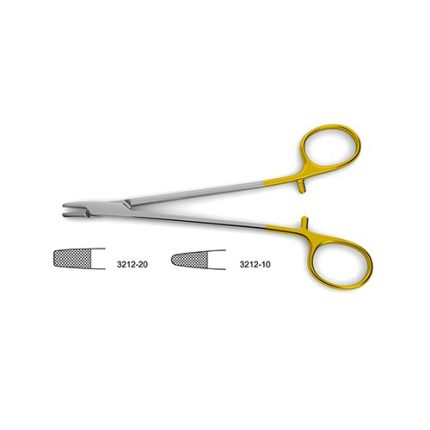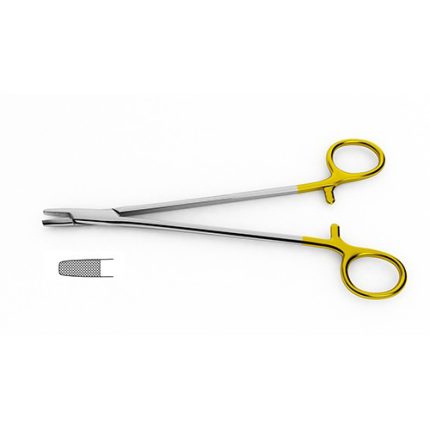Wilde Dressing Forceps – Angled
Wilde Dressing Forceps - Angled
angled, serrated tips
Wilde Dressing Forceps are handcrafted from surgical grade German stainless steel. Designed with angled handles and long serrated tips, this instrument is commonplace among ENT procedures. Available in two lengths, their design allows for use without obstructing the field.
Wilde Ivd Rongeur
fenestrated jaw Wilde IVD Ronger is crafted for use in surgical procedures of the spine that require manipulation and handling of intervertebral discs. These fibro-cartilaginous tissue structures are found interspersed between adjacent vertebrae. A unique aspect of this rongeur is its fenestrated jaw that allows it to apply pressure over a larger surface area which results in the least amount of deformation to the IVD. This instrument is available in 3 lengths: 5.5", 7" and 9" as well as a variety of different jaw lengths and profiles including straight, angled up or down making it suitable for any surgical scenario.
Willett Placenta Praevia Forceps
7-1/2" (19.0 cm) Willett Placenta Praevia Forceps are used in cases of placenta praevia by grasping the scalp of the child with the flat grooved forceps blades and applying continuous traction on the head. This produces a pressure on the placenta to control hemorrhage. The ring handles feature a lock mechanism allowing the obstetrician to use the instrument comfortably and with ease.
Williams Discectomy Rongeur
5-1/2" (14.0 cm) Williams Discectomy Rongeur is a unique instrument made for use in surgical procedures that require manipulation of the intervertebral discs. This rongeur is specifically designed for use in discectomies that can be done to alleviate pain that can be associated with herniated discs. This instrument features ring handled grips that allows it to be comfortably manipulated manually.
Winter Placenta Forceps
Wire Cutting Scissors
Tungsten carbide blades w/ 1 micro serrated blade, angled to side, 4-3/4" (12.1 cm)
Wire Cutting Scissors with blades are handcrafted with tungsten carbide inlays that extend the lifetime and increase the durability of the instrument. micro serrations in combination with the tungsten carbide blades offer an instrument strong enough to cut wire without slipping. scissors combine the performance and precision of supercut with the durability of tungsten carbide cutting edges. These scissors: 1) feature tungsten carbide inlays on both blades for increased durability, sharper cutting edges and enhanced service life; 2) have one standard blade and one with micro-serrations; 3) feature inlays that are soldered onto the blades in a vacuum oven, not welded, resulting in a harder and more durable inlay than those welded on in a traditional process; and 4) feature gold-plated handles with stripes.
Wire Cutting Scissors
Angled to one side, 1 serrated blade, 4-3/4" (12.1 cm)
Wire Cutting Scissors are handcrafted with surgical grade German stainless steel. The serrated blade and angled shank make an instrument strong enough to cut wire without slipping. These scissors have the ability to cut through the most delicate as well the most stubborn material. This instrument is protected by AGO INDUSTRY manufacturer warranty on defects in materials and workmanship.
Wire Extraction Pliers/Forceps – Tungsten Carbide
tungsten carbide jaws, double-action, 7" (17.8 cm) Wire Extraction Pliers/Forceps are a multi-purpose instrument that can be used as pliers to twist and manipulate wire or as a forceps for simple handling. This instrument is designed for heavy use and is made in a double-action pattern, which provides a reliable grip on K-wire and pins. The tungsten carbide also gives this instrument increased durability and an extended service life. Additionally this instrument features gold plated handles and is available with 2.0 mm, 4.0 mm and 6.0 mm jaws.
Wire Pulling Forceps
max capacity 1.0 mm, 6-1/2" (16.5 cm) Wire Pulling Forceps are a specialized instrument ideally suited for using in manipulation of wire. Many neurosurgical and orthopedic procedures require placement of grafts or other things that necessitate some stabilization to prevent injury. Laminectomies and other spinal surgeries especially require the insertion of wire throughout to prevent incomplete healing or trauma and thus these forceps can be used to handle the wire and guide it through different areas. This instrument has a maximum capacity of 1.0 mm.
Wire Tightener
4-3/4" (12.0 cm) Wire Tightener is a specialized instrument ideally suited for handling of wire especially in closure of loops. It is necessary to have an instrument that is specially crafted for handling wire and twisting it without weakening the structure of the material. If particular care is not taken and the appropriate instrument is not applied wires can become weakened at the point where they are twisted making that application more prone to breakage and eventually causing damage and trauma to the patient.
Wire Twister
tungsten carbide inserts, 6" (15.2 cm) Wire Twister is an instrument that has wide surgical applications. This twister features ring handles which makes them easy to manipulate manually to twist and bend wire. There are a number of maneuvers that require addition of wire such as cervical facet wiring. Two strands of wire can be passed through and around a graft that was inserted and used to stabilize it. This technique additionally can be used to stabilize the vertebrae after laminectomies to reduce instability and speed repair. This twister also features tungsten carbide insert and is available in delicate or blunt tips making it suitable for any surgeon preference.
Wire Twister – Cross-Serrated Nose
cross-serrated nose, blunt jaws, tungsten carbide inserts, 8-1/4" (21.0 cm) Wire Twister is an instrument that has wide surgical applications. This twister features ring handles which makes them easy to manipulate manually to twist and bend wire. There are a number of maneuvers that require addition of wire such as cervical facet wiring. Two strands of wire can be passed through and around a graft that was inserted and used to stabilize it. This technique additionally can be used to stabilize the vertebrae after laminectomies to reduce instability and speed repair. This twister also features tungsten carbide insert and features a cross-serrated nose and blunt jaws.



